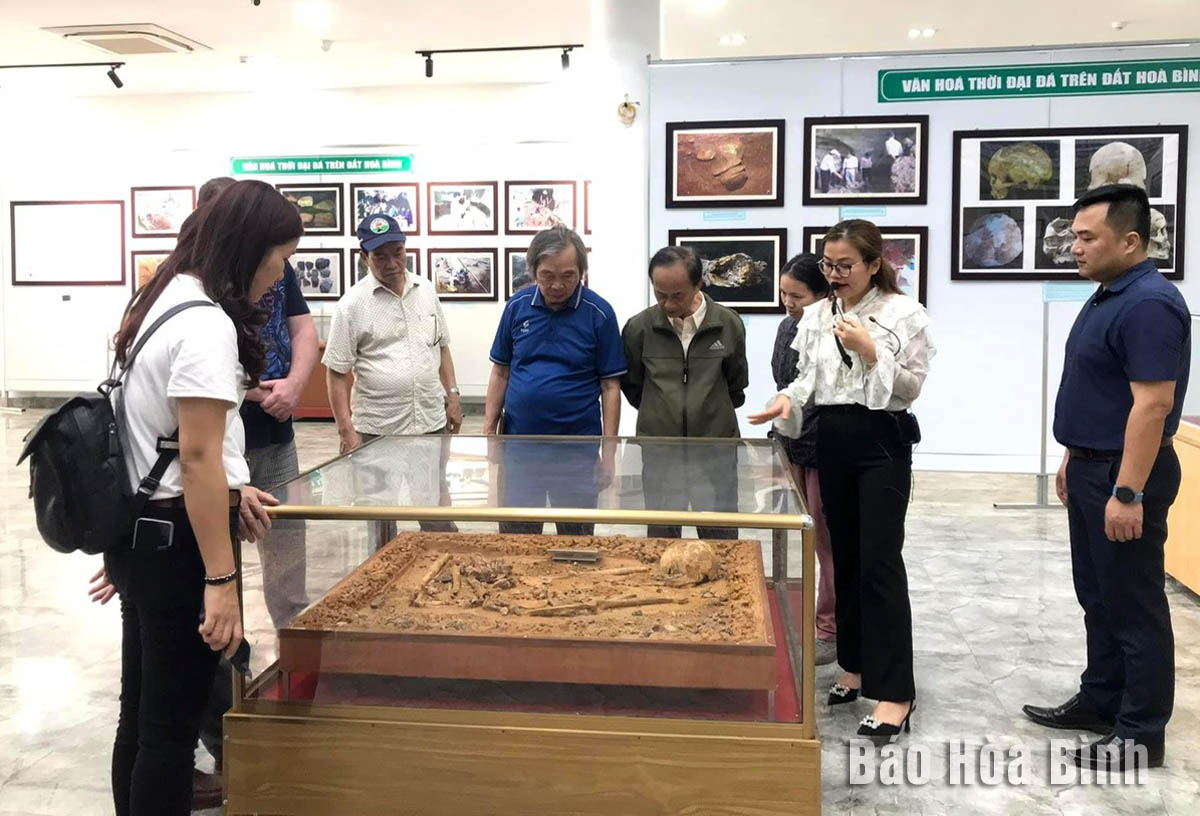
(HBO) – Hoa Binh Culture – a Stone Age culture dating from 18,000 - 7,000 years ago, was discovered by Madeleine Colani - a French female archaeologist in 1926. In 1932, the first conference of Far Eastern pre-historicists meeting in Hanoi recognised the term "Hoa Binh Culture”, named by Colani, as a term to refer to an ancient culture that appeared and existed on territory of prehistoric Vietnam.

Tourists
learn about Hoa Binh Culture artifacts at the provincial Museum.
The Hoa Binh Culture spread throughout
Southeast Asia, but most found relics of the period are concentrated in Hoa
Binh province with over 80 out of 150 relic sites found in Vietnam. The
archaeological sites belonging to "Hoa Binh culture” are mainly located in
clusters of caves or rock shelters. They have been discovered in Trai hamlet’s
cave in Tan Lao district, Vanh hamlet’s rock shelter in Lac Son district, Cho
cave in Luong Son district, Dong Thot cave in Lac Thuy district and Muoi cave
in Tan Lac district.
Over the past years, the work of preserving
and promoting the value of Hoa Binh Culture has received attention from Party
Committees and authorities at all levels. Many archaeological relic sites of
Hoa Binh Culture in the province have been ranked at the national level.
In 2022, the provincial Department of
Culture, Sports and Tourism and the provincial Museum coordinated with the
Institute of Archaeology, the Vietnam Academy of Social Sciences, and Centre
for Southeast Asian Prehistory to conduct archaeological excavations at
national relic sites: Vanh hamlet’s rock shelter and Trai hamlet cave. These
are two typical archaeological relics of Hoa Binh Cultural in the province in
particular and Vietnam in general.
With unique archaeological cultural values
of a world-famous Stone Age culture in Hoa Binh, local authorities are making
scientific documents asking for competent agencies’ recognition of the two
relic sites as special national historical relic sites.
With an increasingly vibrant and widespread emulation movement aimed at building cultured residential areas and cultured families, Yen Thuy District has been making steady progress toward improving both the material and spiritual well-being of its people, while fostering a civilized, prosperous, beautiful, and progressive community.
Once lacking recreational spaces and community facilities, Residential Group 2 in Quynh Lam Ward (Hoa Binh City) has recently received attention for the construction of a new, spacious, and fully equipped cultural house. The project followed the model of state support combined with public contributions in both labor and funding.
The "All people unite to build cultural life" movement, which has been effectively integrated with Kim Boi district’s socio-economic development goals, is fostering a lively spirit of emulation across local residential areas, hamlets, villages, public agencies, and enterprises. In addition, through the initiative, traditional cultural values are being preserved and promoted, while community solidarity and mutual support in poverty reduction and economic development are being strengthened.
A working delegation of the Hoa Binh provincial People’s Committee led by its Permanent Vice Chairman Nguyen Van Toan on June 11 inspected the progress of a project to build the Mo Muong Cultural Heritage Conservation Space linked to tourism services in Hop Phong commune, Cao Phong district.
Born and growing in the heroic land of Muong Dong, Dinh Thi Kieu Dung, a resident in Bo town of Kim Boi district, in her childhood was nurtured by the sweet lullabies of her grandmother and mother. These melodies deeply imprinted on her soul, becoming an inseparable part of her love for her ethnic group's culture. For over 20 years, this love for her hometown has driven Dung to research, collect, and pass down the cultural values of the Muong people to future generations.
In the final days of May, the Ethnic Art Troupe of Hoa Binh Province organized performances to serve the people in remote, mountainous, and particularly disadvantaged areas within the province. These were not just ordinary artistic shows, but they were the meaningful journeys aimed at spreading cultural values, enhancing the spiritual life of the people and contributing to the preservation of ethnic minority cultural identities.



